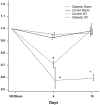Diabetes slows the recovery from urinary incontinence due to simulated childbirth in female rats
- PMID: 17491107
- PMCID: PMC2536602
- DOI: 10.1152/ajpregu.00686.2006
Diabetes slows the recovery from urinary incontinence due to simulated childbirth in female rats
Abstract
This study was done to test the hypothesis that simulated vaginal birth by vaginal distension (VD) causes more severe urinary incontinence and slower recovery in diabetic rats. After measuring baseline leak point pressure (LPP) in 16 diabetes mellitus (DM) and 16 age- and weight-matched control (Ct) female Sprague-Dawley rats, these animals underwent either VD or sham VD (sham). Four and ten days after the procedures, LPP and conscious cystometry were assessed. Tissues were then harvested and examined by light microscopy. LPP at baseline was equal among all four groups. Four days after VD, LPP in both VD groups dropped to significantly lower levels than in sham rats (P < 0.001). Moreover, LPP in the DM+VD group was significantly lower than in the Ct+VD group. At 10 days, LPP in the Ct+VD group had recovered to its baseline value, whereas the LPP in the DM+VD group remained significantly reduced. DM rats had larger bladder capacity and longer voiding intervals than Ct rats. Histological findings included more severe damage to the external sphincter striated musculature of the urethra in DM+VD group compared with Ct+VD. In conclusion, these findings suggest that DM causes increased severity and delayed functional recovery from the effects of simulated childbirth.
Figures




Similar articles
-
Increased duration of simulated childbirth injuries results in increased time to recovery.Am J Physiol Regul Integr Comp Physiol. 2007 Apr;292(4):R1738-44. doi: 10.1152/ajpregu.00784.2006. Epub 2007 Jan 4. Am J Physiol Regul Integr Comp Physiol. 2007. PMID: 17204590 Free PMC article.
-
Analysis of continence reflexes by dynamic urethral pressure recordings in a rat stress urinary incontinence model induced by multiple simulated birth traumas.Am J Physiol Renal Physiol. 2019 Oct 1;317(4):F781-F788. doi: 10.1152/ajprenal.00197.2019. Epub 2019 Jul 17. Am J Physiol Renal Physiol. 2019. PMID: 31313954 Free PMC article.
-
Rat mesenchymal stem cell secretome promotes elastogenesis and facilitates recovery from simulated childbirth injury.Cell Transplant. 2014;23(11):1395-406. doi: 10.3727/096368913X670921. Epub 2013 Jul 17. Cell Transplant. 2014. PMID: 23866688 Free PMC article.
-
Neurogenic aspects of stress urinary incontinence.Curr Opin Obstet Gynecol. 2010 Oct;22(5):425-9. doi: 10.1097/GCO.0b013e32833e499d. Curr Opin Obstet Gynecol. 2010. PMID: 20706117 Free PMC article. Review.
-
The urethra (UPP, MUPP, instability, LPP).Eur Urol. 1998;34 Suppl 1:20-2. doi: 10.1159/000052270. Eur Urol. 1998. PMID: 9705549 Review.
Cited by
-
Animal models of female stress urinary incontinence.J Urol. 2008 Jun;179(6):2103-10. doi: 10.1016/j.juro.2008.01.096. Epub 2008 Apr 18. J Urol. 2008. PMID: 18423691 Free PMC article. Review.
-
Evaluation of the relationship between the pelvic floor muscles and insulin resistance.Diabetes Metab Syndr Obes. 2015 Aug 28;8:409-13. doi: 10.2147/DMSO.S85816. eCollection 2015. Diabetes Metab Syndr Obes. 2015. PMID: 26357485 Free PMC article.
-
Temporal morphological and functional impact of complete urinary diversion on the bladder: a model of bladder disuse in rats.J Urol. 2010 Nov;184(5):2179-85. doi: 10.1016/j.juro.2010.06.090. Epub 2010 Sep 17. J Urol. 2010. PMID: 20850838 Free PMC article.
-
Animal models of stress urinary incontinence.Handb Exp Pharmacol. 2011;(202):45-67. doi: 10.1007/978-3-642-16499-6_3. Handb Exp Pharmacol. 2011. PMID: 21290221 Free PMC article. Review.
-
Pudendal nerve injury reduces urethral outlet resistance in diabetic rats.Am J Physiol Renal Physiol. 2010 Dec;299(6):F1443-50. doi: 10.1152/ajprenal.00341.2009. Epub 2010 Sep 29. Am J Physiol Renal Physiol. 2010. PMID: 20881033 Free PMC article.
References
-
- Altman D, Ekstrom A, Gustafsson C, Lopez A, Falconer C, Zetterstrom J. Risk of urinary incontinence after childbirth: a 10-year prospective cohort study. Obstet Gynecol. 2006;108:873–878. - PubMed
-
- Beshay E, Carrier S. Oxidative stress plays a role in diabetes-induced bladder dysfunction in a rat model. Urology. 2004;64:1062–1067. - PubMed
-
- Brown JS, Seeley DG, Fong J, Black DM, Ensrud KE, Grady D, Study of Osteoporotic Fractures Research Group Urinary incontinence inolder women: who is at risk? Obstet Gynecol. 1996;87:715–721. - PubMed
-
- Brown JS, Vittinghoff E, Lin F, Nyberg LM, Kusek JW, Kanaya AM. Prevalence and risk factors for urinary incontinence in women with type 2 diabetes and impaired fasting glucose: findings from the National Health and Nutrition Examination Survey (NHANES) 2001-2002. Diabetes Care. 2006;29:1307–1312. - PMC - PubMed
-
- Bump RC, Norton PA. Epidemiology and natural history of pelvic floor dysfunction. Obstet Gynecol Clin North Am. 1998;25:723–746. - PubMed
Publication types
MeSH terms
Grants and funding
LinkOut - more resources
Full Text Sources
Medical

